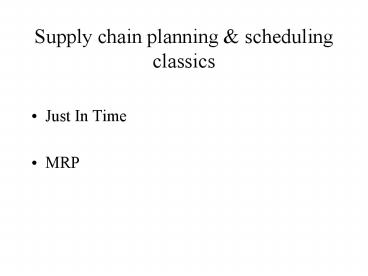Supply chain planning - PowerPoint PPT Presentation
1 / 27
Title:
Supply chain planning
Description:
Supply chain planning & scheduling classics. Just In Time. MRP. Just In Time setting ... to the end item inventory of the production department and puts the card use ... – PowerPoint PPT presentation
Number of Views:29
Avg rating:3.0/5.0
Title: Supply chain planning
1
Supply chain planning scheduling classics
- Just In Time
- MRP
2
Just In Time setting
- Massa production
- Constant demand
- High quality of process steps
- Supplier integration
- Principles zero inventories, eliminate waste,
lean manufacturing
3
Just In Time (logistics)
- Pull Principe
sup- plier
prod 1
prod 3
assem- bly
customer
sup- plier
prod 2
Where is the Customer Order Decoupling Point?
4
Forms of waste
- Excess production
- Waiting times
- Unnecessary transport
- Inventory
- Unnecessary process steps (inspection!)
- Unnecessary activity resulting from defects
5
Quality at the source
- All employees are responsible for quality
Quality at the source. - No inspection
- No fear
- No waste
6
Kanban systems
- Kanban means instruction card
- Kanban systems coordinate production and
inventory replenishment by means of a card system
7
Kanban systems (2)
step 1 Assembly operator takes container type A
from assembly inventory and removes the card
use A from this A container step 2 He moves
to the end item inventory of the production
department and puts the card use kanban A to
an A container on which there is a card produce
A.
inventory
inventory
A
A
production
assembly
B
B
8
Kanban systemen (2)
step 3The assemblu operator removes the produce
A from the container and places in the rack.
step 4 A production operator takes the card
from the rack and starts producing a container of
A (inducing the same sequence of events.)
voorraad
voorraad
A
A
productie
assemblage
B
B
9
Characteristics of kanban systems
- Only produce when there was demand (pull)
- Always produce in the samen quantity
- Inventory position (safety stock?) never exceeds
cards items per container - Elimination of waste is this possible by reducing
items per container or cards.
10
- MRP
11
History of production control
- 50s stone age
- 60s mainframe computers, conception of
centralized planning, Materials requirements
planning(MRP) - 70s Just In Time80s Renewed interest in MRP,
Manufacturing Resource Planning (MRPII) - 90s ERP
- 00s Supply chain, Advanced Planning Scheduling
12
MRP principles
- Required data
- Aggregate plan, specifying demand
- Bill of Materials, recursively specificying how
products (components) are comosed of components. - Lead times, time required to perform each of the
processing steps.
13
Bill Of Materials (BOM)
T
V(3)
U(2)
Y(2)
W(2)
X(2)
W(1)
14
Lead Times
- T 1 week
- U 2 weeks
- V 2 weeks
- W 3 weeks
- X 1 week
- Y 1 week
15
MRP Explosie
16
MRP principes
- Demand can be a mix of forecast and actual orders
- The process of computing the plan from forecast,
BOM and lead times is called MRP explosion - Planning horizon needs to be at least as long as
the longest lead time path in the BOM tree
(supply chain lead time).
17
MRP properties
- master production scheduling (MPS) is the process
of determining end item demand which can be
produced taking capacity restrictions into
account. - MRP itself has no machinery for capacity
restrictions. - Determining an MPS is therefore a nontrivial
problem.
18
MRP versus JIT
- MRP responds well to setting with a variable
demand, JIT performs well with low demand - JIT has continuous improvement incentives
(eliminate waste!) MPS has fixed lead times. - JIT is self organizing and MRPis hierarchical
- MRP is technology driven, JIT uses cards and
people.
19
MRP II (closed loop MRP)
- MRP II have the intelligence to check the
capacity consequences of a master production
schedule. They themselves cannot construct
schedules which satisfy the capacity constraints.
20
Enterprise resource planning
- Some of the presentEnterprise resource planning
systemen have grown out of MRP II systems.
21
Supply chain planning
g1
d1
g2
f1
d2
g3
f2
d3
g4
22
Parameters
- Capacity f1 500
- Capacity f2 1000
- Capacities d1,d2,d3 500
- Demand g1 200
- Demand g2 400
- Demand g3 400
- Demand g4 500
- Cost for transportation from factory i to
distribution center j cij. - Cost for transportation from distribution centre
j to wholesaler k cjk.
Cement can only be transported and sold in
integer quantities
23
Problem
- Find the least cost plan such that all demand is
satisfied and all capacity constraints are
respected..
24
Questions
- Model the problem mathematically.
- What is the complexity of the problem?
- Is it effected by the integrality constraint?
- Suppose there is a third factory with capacity
1000. Remodel the problem with the additional
constraint that only two factories can be used.
25
Knock out question 1
- 5. Assume that the demand quantities are equally
divided between two different product types A and
B. A and B are identical, except for the fact
that their production cost pAi and PBi, i1..3,
are factory dependent.
26
Knock out question 2
6. The presented model is static, i.e. time does
not play a role in it. How must the model be
extended so that demand can be time indexed (as
for instance in the scheduling problem).
27
Additional question on the scheduling problem
- How can it be modelled and solved if there is
more than one raw material, from which each of
the jobs requires a certain subset? - What is the complexity of the resulting problem?































